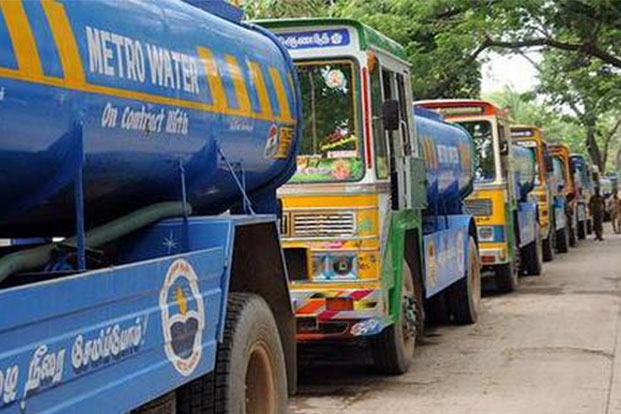It’s a grim situation. With every passing day, the water scarcity in Chennai is turning bleak in localities like OMR with no silver lining in sight. The situation is so alarming that top companies on OMR do not have enough water in their facilities to sustain operations and as a first step have requested their employees to work from home. OMR has about 600 IT and ITES firms operating out of IT parks between TIDEL Park at Taramani and SIPCOT IT Park in Siruseri.
Some of these companies have been insisting that all employees bring water from homes for drinking at work. No one is sure how long these companies can function without water. It’s a tight-rope walk.
But the situation is worse at home for those residing on OMR. Life is a constant struggle to find and store water even for those residing in so called luxury apartments.
OMR requires about three crore litres of water daily in summer and most of this is sourced from outside. IT firms and other offices use up 60% of the water supply.
With borewells running dry and no piped water connection, residents of OMR have no option but to rely on private tankers.
For around four lakh families living in the IT hub of Chennai, one of their biggest fears almost came true when private water tankers threatened to go on strike from May 27. But the strike was called off at the last minute.
According to a report in The News Minute, with groundwater and borewells going dry, OMR residents in several neighbourhoods are forced to rely completely on water tankers– private players and the Chennai Metropolitan Water Supply and Sewerage Board (CMWSSB). Residents complain that they are at the mercy of these tankers who jack up the prices depending on daily demand. It’s either pay up or go without water as the residents cannot afford to take on the water cartel.
Some gated communities pay up to Rs 2000 per tanker and need more than 20 loads daily. So, you can very well imagine the money that every family needs to shell out for what is a basic need.
Surprisingly, tankers from CMWSSB do not supply to this stretch. Even communities within Chennai limits complain of the gaps in their online booking system which crashes often. In any case, it can take more than a week for a tanker to reach a building after booking.
For nearly 10 years, association residents have been appealing to CMWSSB to provide them with a water pipeline connection with no success. There was hope that water from the Nemmeli desalination plant would be made available to residents of OMR. But it still remains an unfinished promise with a blame game on between Chennai Corporation, the Public Works Department and CMWSSB for lack of progress. A CMWSSB official linked the delay in execution of infrastructure work to the rocky terrain around OMR. This makes it three times more difficult to carry out the work. Interestingly, around 30% of the property taxes go towards water and sewage management, according to a report.
There has also been criticism that Chennai’s expansion and the hurried construction of apartments on the OMR has in many ways brought about this crisis, TNM noted. There are residents who now regret the decision to move into a fast developing OMR.
The CMWSSB supplies around 525 MLD of water to Chennai every day when demand is 830 MLD during the peak summer season.
Unfortunately, the scarcity and struggle will continue for at least the next 100 days. A report in the TimesOfIndia noted that Chennai has not received any rainfall for almost 200 days. What is more scary is the warning by experts that Chennai may not get enough rains to tide over the water crisis for the next three months.
We hope that a permanent and long-term solution is found for the acute water scarcity faced by residents in and around OMR.
In sharp contrast to their water woes is the round-the-clock water supply in townships like Hiranandani Parks in Oragadam which has invested in rain-water harvesting, sophisticated water treatment plant with a capacity of 2.34 million liters daily and blessed with a stable ground water table, natural greenery along with an ecologically healthy eco-system. The focus on eco-friendly practices also helps.

